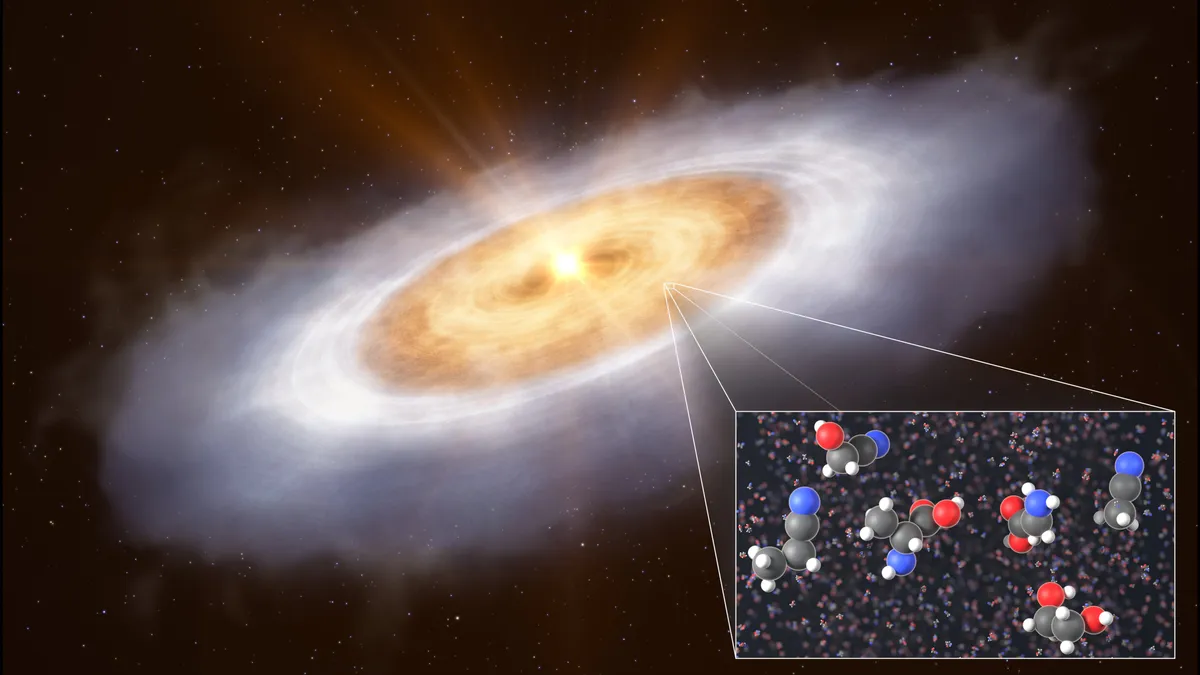
Using the Atacama Large Millimeter/submillimeter Array (ALMA), a team of astronomers led by Abubakar Fadul from the Max Planck Institute for Astronomy (MPIA) has made a groundbreaking discovery of complex organic molecules (COMs) in the protoplanetary disk surrounding the outbursting protostar V883 Orionis. This includes the first tentative detection of ethylene glycol and glycolonitrile, both of which are considered precursors to the essential building blocks of life.
Complex organic molecules are defined as those containing more than five atoms, at least one of which is carbon. Many of these molecules are critical for life, including amino acids and nucleic acids or their precursors. The discovery of 17 different COMs in the protoplanetary disk of V883 Orionis provides a significant insight into the evolutionary journey of these molecules as they transition from the stages leading to star formation to fully developed planetary systems.
Glycolonitrile, one of the molecules identified, serves as a precursor to vital amino acids such as glycine and alanine, in addition to the nucleobase adenine. According to Fadul, “Our finding points to a straight line of chemical enrichment and increasing complexity between interstellar clouds and fully evolved planetary systems.”
The transformation from a cold protostar to a young star surrounded by a disk of gas and dust initiates a violent phase characterized by shocked gas, intense radiation, and rapid gas ejection. These high-energy processes could potentially obliterate the complex chemistry that had previously formed. Traditionally, scientists have proposed a "reset scenario," where the necessary chemical compounds for life would need to be recreated in circumstellar disks while forming comets, asteroids, and planets.
However, the findings from the MPIA team suggest the opposite. Co-author Kamber Schwarz states, “Our results suggest that protoplanetary disks inherit complex molecules from earlier stages, and the formation of complex molecules can continue during the protoplanetary disk stage.” This indicates that the conditions essential for biological processes may be more widespread than previously thought.
Previously, astronomers have detected simpler organic molecules, such as methanol, in dense regions of dust and gas that predate star formation. Under favorable conditions, these regions may also harbor complex compounds like ethylene glycol, which was recently discovered in V883 Orionis. Tushar Suhasaria, a co-author and head of MPIA's Origins of Life Lab, explains, “We recently found that ethylene glycol could be formed by UV irradiation of ethanolamine, a molecule also discovered in space.”
This finding not only supports the idea that ethylene glycol can form in interstellar environments but also during later stages of molecular evolution, where UV irradiation plays a key role. More evolved biological agents, such as amino acids, sugars, and nucleobases that constitute DNA and RNA, are already known to exist in asteroids, meteorites, and comets in our solar system.
The chemical reactions that lead to the synthesis of these complex organic molecules typically occur in cold conditions, preferably on icy dust grains that eventually coalesce into larger celestial bodies. These molecules often remain hidden, only accessible through space probes or external heating that can evaporate the ice. In the solar system, our sun heats comets, creating impressive tails of gas and dust, or comas, which facilitate the detection of the molecules through spectroscopy—the analysis of light spectra.
A similar heating process is taking place in the V883 Orionis system. The central star is still in a growth phase, accumulating gas from its surrounding disk until it ignites fusion in its core. During this growth, the infalling gas heats up and generates intense radiation outbursts, which can heat the surrounding disk to the point of releasing the detectable chemicals.
While this discovery is indeed promising, the research team acknowledges that they have yet to fully interpret all the signatures in their spectra. Schwarz notes, “Higher resolution data will confirm the detections of ethylene glycol and glycolonitrile, and may even reveal more complex chemicals that we haven't identified yet.”
Fadul adds that exploring other regions of the electromagnetic spectrum may yield even more evolved molecules. The potential for future discoveries in the realm of complex organic molecules is vast, and the implications for our understanding of life's origins could be monumental.